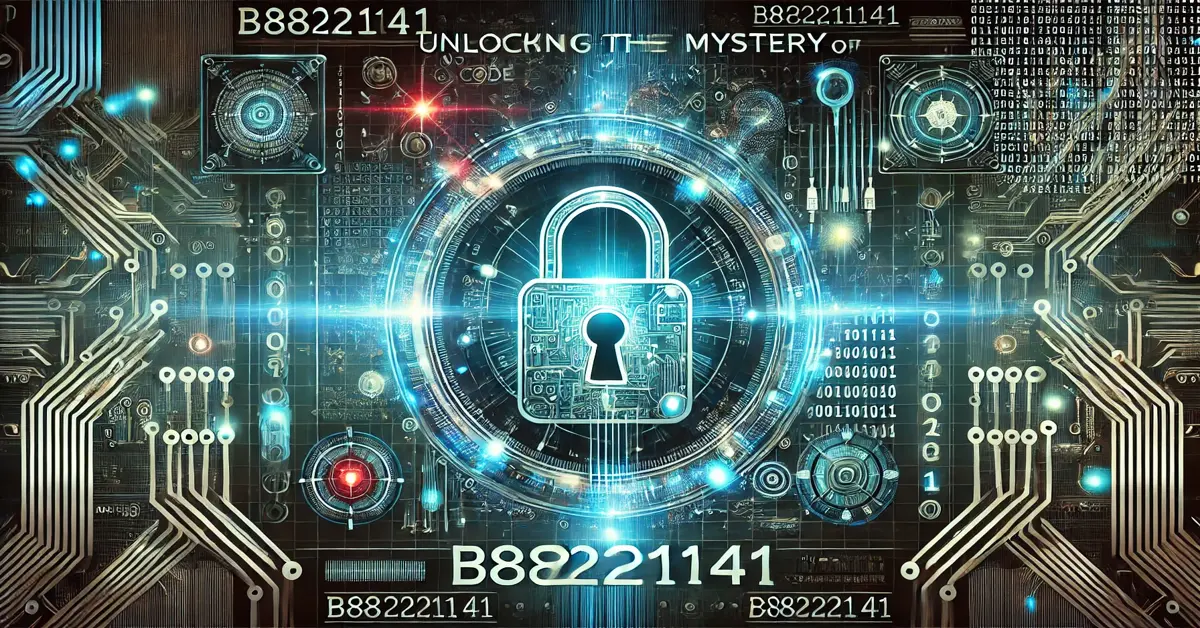In an era dominated by data, codes, and algorithms, one sequence stands out in its intrigue and versatility: b88221141. At first glance, it might appear to be just another random series of letters and numbers, but behind this seemingly arbitrary string lies a story of innovation, security, and transformation in the technological landscape. From its role in encryption protocols to its influence on data security, b88221141 serves as a gateway to understanding the inner workings of digital infrastructure. This article aims to decode the significance of b-88221141, exploring its origins, applications, and why it matters in today’s world.
The Origins of b88221141
The origins of b88221141 are as elusive as they are fascinating. While there’s no definitive answer to where this specific sequence came from, its rise to prominence can be traced back to the early days of the digital age, when security and encryption became crucial components of modern technology.
Some experts suggest that b-88221141 was conceived in the early 2000s, during a time when the internet was rapidly expanding, and online communications were becoming more vulnerable to attacks. Others believe that its creation was purely accidental—possibly originating from a glitch or coding error that was later refined into something more sophisticated.
Regardless of its beginnings, one thing is certain: b-88221141 has evolved into a symbol of advanced technology, especially in fields that require secure data transmission, such as finance, healthcare, and cybersecurity. The mystery surrounding its origin only adds to its allure, prompting speculation and curiosity among tech enthusiasts, cryptographers, and data scientists alike.
What is b88221141?
So, what exactly is b88221141? Unlike more familiar codes and acronyms in technology, such as TCP/IP or HTML, b-88221141 doesn’t stand for a universally recognized protocol or system. Instead, it’s a unique identifier used across various platforms and technologies, with different meanings depending on its context.
For example, in encryption, b-88221141 could represent a key or a sequence of characters used in a cryptographic algorithm to protect sensitive data. In software development, it might be a version number, unique identifier, or a reference code within a larger system. The beauty of b-88221141 lies in its flexibility—able to adapt and be applied in multiple environments while retaining its importance as a secure, high-level code.
In essence, b-88221141 is more than just a number. It’s a bridge between different technological spheres, enabling secure communication and enhancing the overall stability of digital infrastructure.
The Role of b88221141 in Data Security
One of the most significant contributions of b88221141 is in the realm of data security. As the digital world has expanded, so has the threat of cyberattacks, data breaches, and unauthorized access. With personal information, financial records, and corporate data at risk, robust security measures have become essential. This is where b-88221141 comes into play.
In the context of encryption, b-88221141 is often used as part of a larger cryptographic algorithm designed to secure data in transit and at rest. Encryption works by transforming readable data (plaintext) into a scrambled, unreadable format (ciphertext) using an encryption key. This makes it virtually impossible for unauthorized individuals to access the original information without the corresponding decryption key.
By integrating b-88221141 as part of this process, businesses and institutions can strengthen their defenses against hacking attempts, ensuring that sensitive information remains confidential. Whether it’s used in SSL certificates for secure website communications, financial transactions, or medical records, b-88221141 plays a crucial role in safeguarding data in an increasingly interconnected world.
Technological Applications of b88221141
As technology advances, the applications of b-88221141 have expanded beyond encryption and security. Today, this code is used in a variety of fields, including software development, cloud computing, blockchain technology, and even artificial intelligence (AI).
1. Software Development
In software development, b88221141 may serve as a unique identifier or versioning system for different software builds. This helps developers track changes, manage updates, and ensure compatibility between various components. The versatility of b-88221141 allows it to be incorporated into software environments as a way to maintain order in an otherwise chaotic and fast-paced development landscape.
2. Cloud Computing
With the rise of cloud-based infrastructure, b-88221141 is increasingly used to manage user access, data synchronization, and server-side processes. Cloud computing requires robust security measures to protect data stored on remote servers, and b-88221141 can be an integral part of these protocols. Whether it’s controlling access to sensitive information or monitoring server activity, b-88221141 provides the foundation for a secure cloud ecosystem.
3. Blockchain Technology
In blockchain systems, which rely on decentralized networks and cryptographic principles, b-88221141 may be used as part of smart contracts or transaction verifications. Blockchains need highly secure mechanisms to validate and record transactions, and incorporating b-88221141 into these processes helps ensure that records are tamper-proof and traceable. This enhances trust and transparency in blockchain-based systems, such as cryptocurrencies or decentralized applications.
4. Artificial Intelligence
AI and machine learning applications often rely on vast amounts of data and complex algorithms to function. b88221141 can be used to encode or tag datasets, ensuring that AI models have access to the right information while maintaining security and integrity. Additionally, b-88221141 may be employed to track training processes or distinguish between different AI iterations.
How b88221141 Enhances Everyday Life
While much of the discussion around b-88221141 centers on its technological impact, it’s important to recognize how it influences everyday life. In many ways, b-88221141 touches the average user without them even realizing it. From making online shopping more secure to protecting personal data on social media platforms, this code is silently working in the background to improve the digital experience.
1. Secure Online Transactions
When making online purchases or conducting financial transactions, encryption algorithms like b-88221141 ensure that credit card details, passwords, and other sensitive data are transmitted securely. This helps prevent fraud, identity theft, and unauthorized access to personal accounts.
2. Medical Record Privacy
Healthcare providers increasingly rely on digital systems to store and manage patient records. b-88221141 plays a role in ensuring that these records remain confidential, protecting sensitive medical information from unauthorized access or data breaches.
3. Social Media Security
Many social media platforms use encryption techniques that involve codes like b88221141 to safeguard user data, protect private messages, and secure account credentials. This provides peace of mind for users, knowing that their personal information is safe from prying eyes.
Future Prospects for b88221141
As the world becomes more dependent on digital infrastructure, the importance of codes like b-88221141 will continue to grow. In the coming years, we can expect to see this sequence playing a more prominent role in shaping cybersecurity, data privacy, and technological innovation.
Advancements in quantum computing and AI may lead to new applications for b-88221141, especially in fields requiring ultra-secure communications and data processing. As technology evolves, b-88221141 will adapt to meet the challenges of a rapidly changing world, ensuring that data remains secure, efficient, and protected.
Conclusion
In conclusion, b88221141 is much more than a random sequence of numbers and letters. It is a testament to the progress that technology has made, especially in the areas of encryption, data security, and digital innovation. From its mysterious origins to its diverse applications, b88221141 serves as a crucial tool in today’s digital landscape, silently shaping our interactions with technology while ensuring our data stays safe.
As we move forward into a future driven by data and technology, the role of b88221141 will only become more significant. Whether it’s used in protecting financial transactions, enhancing blockchain security, or securing AI models, b88221141 will remain at the forefront of technological advancement.
FAQs
1. What is the significance of b88221141 in encryption?
b88221141 is used as part of encryption protocols to secure data. It helps protect sensitive information by scrambling it into unreadable formats, ensuring that only authorized parties can access it.
2. Can b88221141 be linked to a specific technology?
No, b88221141 is a versatile identifier that can be applied across various technologies, including software development, cloud computing, blockchain, and artificial intelligence.
3. Is b88221141 widely used in financial services?
Yes, b88221141 plays a crucial role in financial services, particularly in secure online transactions, protecting user data during financial exchanges, and managing loan systems.
4. How does b88221141 impact data security?
b88221141 enhances data security by acting as a component in encryption algorithms. It helps safeguard personal, financial, and medical data from unauthorized access or hacking attempts.
5. What role does b88221141 play in blockchain technology?
In blockchain systems, b88221141 may be used in smart contracts and transaction verification processes, helping to ensure that records are immutable and trustworthy.
6. What future advancements could involve b88221141?
As technology evolves, b88221141 could become integral to quantum computing, advanced AI applications, and next-generation encryption techniques designed to meet future cybersecurity challenges.





